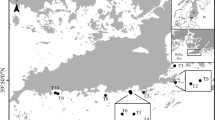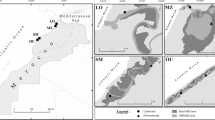Abstract
Seagrass meadows are sites that help mitigate the effects of climate change. The protected area of the Laguna Madre of Tamaulipas is an important site for its biodiversity, which has undergone changes both in the structure and distribution of its seagrass meadows. Five seagrass species were found (Halodule wrightii, Syringodium filiforme, Thalassia testudinum, Ruppia maritima and Halophila engelmannii), forming multispecific meadows. The south zone presented the longest and broadest leaves, but the lowest biomass. Biomass was greatest in the center zone, whereas the highest density were observed in the north zone. The structure analysis showed that the longest and the densest seagrass meadows were S.filiforme. The greatest biomass was recorded for T.testudinum. The meadows with the greatest cover consisted of H.wrightii-S.filiforme. There is little fragmentation of the landscape, and a large succession of species. This indicates change processes, due to the variation in environmental conditions, caused by anthropic modifications, in the lagoon. Due to its importance as an environmental bioindicator, it is necessary to monitor changes in the patterns of structure, fragmentation and succession of species. The present research provides evidence of the change in the distribution of tropical seagrass cover, which may be related to the tropicalization of temperate ecosystems and the need to conserve these habitats.





Similar content being viewed by others
References
Arellano-Méndez LU, Herrera-Silveira JA, Montero-Muñoz JL, Liceaga-Correa MA (2011a) Morphometric trait variation in Thalassia testudinum (Banks ex König) associated to environmental heterogeneity in a subtropical ecosystem. J Ecosys Ecograph S1:001. https://doi.org/10.4172/2157-7625.S1-001
Arellano-Méndez LU, Liceaga-Correa MA, Herrera-Silveira JA, Hernández-Núñez H (2011b) Impacto por huracanes en las praderas de Thalassia testudinum (Hydrocharitaceae) en el Caribe Mexicano. Rev Biol Trop 59(1):385–401 http://www.redalyc.org/articulo.oa?id=44918841034
Arellano-Méndez LU, Bello-Pineda J, Aké-Castillo JA, Pérez-España H, Martinez-Cardenas L (2016) Distribución espacial y estructura morfométrica de las praderas de Thalassia testudinum (Hydrocharitaceae) en dos arrecifes del Parque Nacional Sistema Arrecifal Veracruzano, México. Rev Biol Trop 64(2):427–448 http://www.redalyc.org/articulo.oa?id=44945722001
Bennet A (2003) Linkages in the landscape: the role of corridors and connectivity in wildlife conservation. IUCN. Gland, Switzerland. 254 pp. ISBN: 2-8317-0744-7
Brazda AR (1988) Winter waterfowl populations and habitat evaluation aerial surveys East Coast of Mexico. 575-593 pp. In: Ecología y conservación del delta de los rios Usumacinta y Grijalva (Memorias). INIREB-División Regional Tabasco. Gobierno del Estado de Tabasco
Britton JC, Morton B (1989) Shore ecology of the Gulf of Mexico, vol 387. University of Texas Press, Austin
Carrera E (1993) Inventario de humedales de la Laguna Madre de Tamaulipas. In: Memorias del V Simposio Internacional de Fauna Silvestre. Universidad Autónoma de Tamaulipas. Cd. Victoria, Tamaulipas. 14-22 pp.
Cervantes (ed) (1994) Humedales prioritarios de México. Ficha No. 5 Laguna Madre. Boletín humedales de México 2(6):7–8
Cornelius SE (1975) Food Choice of wintering redhead ducks (Aythya americana) and utilization of available resources in Lower Laguna Madre, Texas. Tesis M.S. Texas A&M University. Collage Station. 121 pp.
Cruz-Palacios V, van Tussenbroek BI (2005) Simulation of hurricane-like disturbances on a Caribbean seagrass bed. J Exp Mar Biol Ecol 324:44–60. https://doi.org/10.1016/j.jembe.2005.04.002
Cunha AH, Santos R, Gaspar AP, Bairros MF (2005) Seagrass landscape-scale changes in response to disturbance by barrier-islands dynamics: a case study from ria Formosa (south of Portugal). Estuar Coast Shelf Sci 64:636–644. https://doi.org/10.1016/j.ecss.2005.03.018
DUMAC. (2011). Inventario y clasificación de humedales de México. Sitios Ramsar
Forman RTT (1995) Land mosaics: the ecology of landscapes and regions. New York: Cambridge University Press. ISBN-10: 0521479800. ISBN-13: 9780521479806
Gullström M, Lundén B, Bodin M, Kangwe JW, Öhman MC, Mtolera MSP, Björk M (2006) Assessment of changes in the seagrass-dominated submerged vegetation of tropical Chwaka Bay (Zanzibar) using satellite remote sensing. Estuar Coast Shelf Sci 67:399–408. https://doi.org/10.1016/j.ecss.2005.11.020
Haag SM, Kennish MJ, Sakowicz GP (2008) Seagrass habitat characterization in estuarine waters of the Jacques Cousteau National Estuarine Research Reserve Using Underwater Videographic Imaging Techniques. J Coast Res 10055:171–179. https://doi.org/10.2112/SI55-011.1
Hemminga MA, Duarte CM (2000) Seagrass Ecology. Cambridge (United Kingdom): Cambridge University Press. ISBN: 0-521-66184-6
Herrera-Silveira JA (2006) Lagunas Costeras de Yucatán (SE, México). Ecotrópicos 19:94–108 http://www.saber.ula.ve/bitstream/123456789/25598/1/articulo3.pdf
Herrera-Silveira JA, Ramírez-Ramírez J, Gómez N, Zaldivar A (2000) Seagrass bed recovery after hydrological restoration in a costal lagoon with groundwater discharges in the North of Yucatán, p. 123–135. In: Bortone, S. (ed.). Seagrass: monitoring ecology, physiology and management. CRC, Boca Raton, Florida, EEUU. ISBN: 9780849320453
Hildebrand HH (1958) Estudios biológicos preliminares sobre la Laguna Madre de Tamaulipas. México. Ciencia 17(7–9): 151–173
Hilty JA, Lidicker WZ, Merenlender AM (2006) Corridor ecology: the science and practice of linking landscapes for biodiversity conservation. Washington: Island Press. ISBN-10: 1559630965. ISBN-13: 978-1559630962
Lee Long WJ, McKenzie LJ, Rasheed MA, Coles RG (1996) Monitoring seagrasses in tropical ports and harbours 345–350 pp. In: Kuo, J., Phillips, R.C., Walkers, D. I., Kirkman, H. (eds). Seagrass Biology: Proceedings of an International Workshop, Rottnest Island, Western Australia 25–29 January, 1996. Faculty of Sciences, The University of Western Australia. ISBN: 0864224451
Legendre L, Legendre P (1998) Numerical ecology. Developments in environmental modelling. Elsevier Scientific Publishing Company. New York. ISBN: 0-444-89249-4
Liceaga-Correa MA, Arellano-Méndez LU, Hernández-Núñez H (2010) Efectos de los huracanes y cambio climático sobre el Caribe Mexicano: adaptabilidad de los pastos marinos. In: Botello, A. V., Villanueva-Fragoso, S., Gutiérrez, J., Rojas Galaviz, J. L., (eds). Vulnerabilidad de las zonas costeras mexicanas ante el cambio climático Gobierno del Estado de Tabasco. SEMARNAT-INE, UNAM-ICMyL, Universidad Autónoma de Campeche. 514pp. ISBN: 978–607-7887-11-9
Liebhold M, Gurevitch J (2002) Integrating the statistical analysis of spatial dates in ecology. Ecography 25: 553–557. ISSN: 0906-7590
Lot A, Novelo A, Ramirez-Garcia P (1986) Listados florísticos de México V. Angiospermas Acuáticas Mexicanas 1. Instituto de Biología. UNAM. México, D.F. 60 pp.
MacArthur RH, Wilson EO (1967) The Theory of Island Biogeography. Princeton, N.J.: Princeton University Press, 203 p.
Martínez M, Novelo A (1993) La vegetación acuática del Estado de Tamaulipas, México. Anales Inst Biol UNAM México Serie Botánica 64(2):59–86
Mora-Olivo A (1996) Vegetación acuática de la Laguna Madre de Tamaulipas (pastos marinos). Informe Final de Proyecto. Universidad Autónoma de Tamaulipas. 44 pp.
Mora-Olivo A, Mora-López JL (1995) Vegetación acuática. In: Manifestación de Impacto Ambiental Canal Intracostero Tamaulipeco. Universidad Autónoma de Tamaulipas. Informe Técnico. Cd. Victoria, Tamaulipas, México
O’Neill RV, Krummel JR, Gardner RH, Sugihara G, Jackson B, Deangelis DL, Dale VH, Graham RL (1988) Indices of landscape pattern. Landsc Ecol 1:153–162. https://doi.org/10.1007/BF00162741
Pérez-Arteaga A, Gaston KJ, Kershaw M (2002) Population trends and priority conservation sites for Mexican Duck Anas diazi. Bird Conservation International 12(1):35–52. https://doi.org/10.1017/S0959270902002034
Pérez-Castañeda R, Blanco-Martínez Z, Sánchez-Martínez JG, Rábago-Castro JL, Aguirre-Guzmán G, Vázquez-Saucedo ML (2010) Distribution of Farfantepenaeus aztecus and F. duorarum submerged aquatic vegetation habitats along a subtropical coastal lagoon (Laguna Madre, México). J Mar Biol Assoc UK 90(3):445–452. https://doi.org/10.1017/S0025315409990865
Taylor PD, Fahrig K, Henein K, Merriam G (1993) Connectivity is a vital element of landscape structure. Oikos 68:571–573. https://doi.org/10.2307/3544927
Tunnell JW Jr, Judd FW (2002) The Laguna Madre of Texas and Tamaulipas. Texas A&M University Press. Corpus Christi. 346 pp
Vila S, Varga D, Llausás A, Ribas A (2006) Conceptos y métodos fundamentales en ecología del paisaje (landscape ecology). Una interpretación desde la geografía. Documentos de los Anales de Geografía. 48:151–166. http://web2.udg.edu/aigua/material/Conceptos%20y%20m%C3%A9todos%20fundamentales%20en%20ecolog%C3%ADa%20del%20paisaje_DAG_48_2006.pdf
Yáñez-Arancibia A (ed) (2010) Impactos del Cambio Climático sobre la Zona Costera. Instituto de Ecología A.C. (INECOL), Texas Sea Grant Program, Instituto Nacional de Ecología (INE-SEMARNAT), México
Young D, Young M (1982) Macrobenthic invertebrates in bare sand and seagrass (Thalassia testudinum) at Carrie Bow Cay, Belize. In: Rutzler K, MacIntyre IE, eds. The Atlantic barrier reef ecosystem at Carrie Bow Cay, Belize. I. Structure and communities. Smithsonian Contribution for Marine Science. 12: 115–126. https://doi.org/10.1086/413484
Acknowledgements
The present study was carried out thanks to the Programa de Mejoramiento del Profesorado (Promep), as part of the project “Distribución Espacial, Estructura y Contenido de Carbono en Praderas de Macrófitas Sumergidas Existentes en la Laguna Madre de Tamaulipas” (UAT-PTC-149). “The Authors declares that there is no conflict of interest”.
Author information
Authors and Affiliations
Corresponding author
Additional information
Publisher’s note
Springer Nature remains neutral with regard to jurisdictional claims in published maps and institutional affiliations.
Rights and permissions
About this article
Cite this article
Arellano-Méndez, L.U., Mora-Olivo, A., Zamora-Tovar, C. et al. Structural complexity of tropical seagrasses meadows in a temperate lagoon in the Gulf of Mexico. A landscape ecology approach. J Coast Conserv 23, 969–976 (2019). https://doi.org/10.1007/s11852-019-00701-2
Received:
Revised:
Accepted:
Published:
Issue Date:
DOI: https://doi.org/10.1007/s11852-019-00701-2




